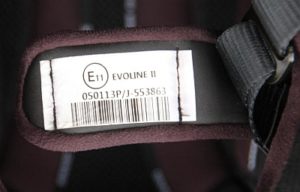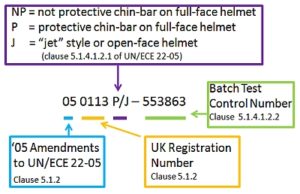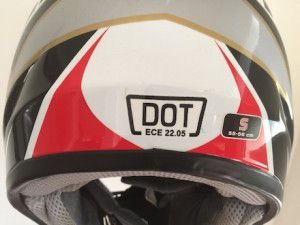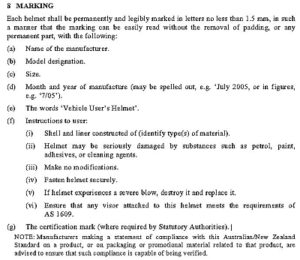Whatever it is, make sure it FITS YOUR HEAD.
About 10% of helmets come off in crashes. Fasten the strap.
Don’t buy a helmet you haven’t had on YOUR head.
Helmet fit is REALLY important.
On Friday the 11th of December 2015, NSW Road Rule 270 was amended to allow the use of the International Helmet standard UN ECE 22.05 in NSW.
This Amendment additionally moved the definition of an approved motor bike helmet into the published road rule, rather than the past practice of obscuring the definition in date-order Government Gazettes.
While the National Road Rule Road Rule 270 is basically the same in all states, requiring a rider to wear an approved helmet correctly fastened on their head, the definition for an approved motor bike helmet continues to vary within each state.
ALL States and Territories now require use of an approved helmet that bears evidence of having been Certified as compliant with AS/NZS 1698:2006, or ECE 22-05 or AS 1698-1988. The “evidence” is a mark, label or sticker in and/or on the helmet.
European helmets are “homologated” by a European government. Australian Standard helmets are “Certified” by a privately owned certification services company.
The labels are quite different, reflecting the different processes.
ECE 22-05
AS/NZS 1698:2006
The introduction of ECE 22-05 helmets since 2016 has been warmly welcomed by riders, allowing safer helmets and a less restricted market.
Compliance with ECE 22-05 means it is marked in accordance with Clause 5.1.9 of ECE 22-05. This requires a label sewn onto the chin-strap (“retention system”) that carries quite specific (and very informative) information.

The label above is an example of a compliance label for ECE 22-05. In the circle it shows “E11” where E11 = United Kingdom, i.e. this helmet was homologated by the British government. Of interest, this is a “flip up” helmet that achieved homologation as BOTH an open face and full-face; the chin-bar can rotate to a locked position at the rear and does not form a “protrusion”.
Critical information is easily decoded from 050113 P/J – 553863 as seen on the label above.
Below are shown the codes, their meaning and the clauses of ECE 22-05

The above tells us who to contact for full compliance test details of THIS helmet (for proof of design and proof of production reliability).
The Batch Test Control Number links THIS helmet to the particular production batch it came from and the batch tests for that batch. It’s under regulatory control.
If it doesn’t have the chin-strap tag with the above details, it’s not UN/ECE 22-05 compliant, despite any other labels.
On some ECE helmets, the label is behind a sheathing over the chin-strap. To read the label, the sheathing can be pushed back while holding the strap with the other hand.
E numbers
1 for Germany, 2 for France, 3 for Italy, 4 for the Netherlands, 5 for
Sweden, 6 for Belgium, 7 for Hungary, 8 for the Czech Republic, 9 for Spain, 10 for Yugoslavia, 11 for the United Kingdom, 12 for Austria, 13 for Luxembourg, 14 for Switzerland, 15 (vacant), 16 for Norway, 17 for Finland, 18 for Denmark, 19 for Romania, 20 for Poland, 21 for Portugal, 22 for the Russian Federation, 23 for Greece, 24 for Ireland, 25 for Croatia, 26 for Slovenia, 27 for Slovakia, 28 for Belarus, 29 for Estonia, 30 (vacant), 31 for Bosnia and Herzegovina, 32 for Latvia, 33 (vacant), 34 for Bulgaria, 35 (vacant), 36 for Lithuania, 37 for Turkey, 38 (vacant), 39 for Azerbaijan, 40 for The former Yugoslav Republic of Macedonia, 41 (vacant),
Below, IS NOT an ECE 22-05 compliance label.

For Australian Standards, you need to find an approval label inside the helmet that has details required by AS/NZS 1698:2006. Labels required by AS 1698-1988 are the same.
Clause 8 of AS/NZS 1698 requires marking that can be “easily read without removal of the padding”. These are INSIDE the helmet.
Below: Clause 8 from AS/NZS 1698:2006:-
Here’s a few inside labels from helmets certified to AS/NZS 1698
Contact Info
The Motorcycle Council of NSW Inc.
PO Box 517
Parramatta 2124
Ph: 1300 679 622 (1300 NSW MCC)
General Enquiries
Please direct enquiries to:
MCCNSW Email
enquiries@mccofnsw.org.au
Site Menu